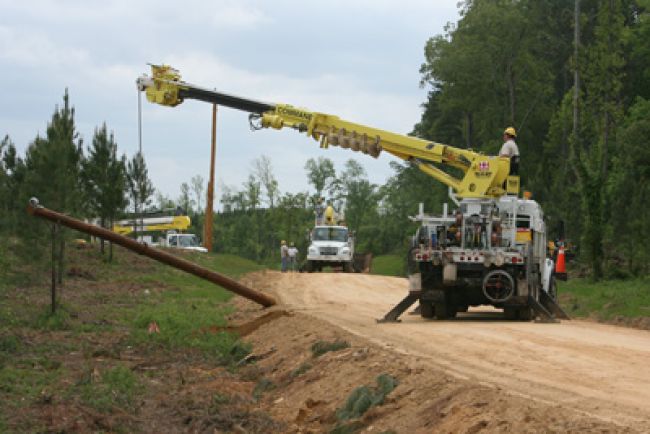
The Impact of Soil Conditions on Digger Derrick Auger Selection
If you don’t have the optimal tool for the job, you might still be able to get the work done. But it often requires more time and effort to perform the task and shortens the life of the tool.
That’s especially the case with augers. An auger is like a drill bit, attached to the boom of a digger derrick and designed to drill into the ground to dig holes in which to set poles. The properly spec’d auger empowers your crews to dig holes as quickly and efficiently as possible.
And one of the major factors in selecting the right auger is the soil type, whether it’s loose dirt, sand, mud, rock or extreme rock. So, here are four important items to consider to ensure your augers are best suited for the various soil conditions your crews may encounter.
1. Flight Length
The flighting is the spiral section near the bottom tip of the auger, much like what you would see on a corkscrew. “Flight length” refers to the auger’s total spiral length, which typically ranges from 52 to 60 inches.
Why does this matter? “If the tool is digging into a real sandy or loose dirt area, the longer flighting allows you to pull more material out of the ground at one time. Otherwise, you’re having to repeat the task several more times to pull out enough dirt to secure the hole,” explained Dale Putman, product support manager for auger tooling and drills with Terex Utilities (www.terex.com/utilities).
2. Flight Thickness
This refers to the material thickness of each flight, which impacts both the strength and weight of the tool. The objective is to strike the right balance between building sufficient strength for the application and avoiding adding unnecessary weight to the auger, which would detract from the digger derrick’s overall payload.
“[At Terex], we like to go with a thicker flight at the bottom of the auger for heavier-duty applications,” Putman said. “We’ll build a 1-inch-thick flight at the bottom and then we may go to 3/8- or 5/16-inch on the flights above that. A stronger cutting edge [bottom flight] of the auger makes it much easier on the tool to cut into rock.”
3. Flight Pitch
This represents the distance between the top and bottom of each spiral or flight. The shorter the distance, the flatter the pitch. More space between top and bottom will make the flight pitch steeper.
What’s the impact of flight pitch on auger performance? “When digging into loose soil with a steep flight pitch, all the material will just slide right back into the hole every time you try to pull the tool out,” Putman said. “If you go with the flatter pitch, the material stays on the flighting a lot better.”
Putman also said that a steeper pitch is more useful when you’re drilling into wet, sticky clay and gummy dirt. “This way, when you pull the tool out of the hole, it will be easier and faster to get the clumpy material off the tool.”
4. Teeth
The pilot bit, found at the tip of the auger, creates the starter hole to help hold the auger straight before it goes into full-power drilling mode. Right above the pilot bit and below the first flight is a set of teeth designed to cut into the ground. There are typically three different types of teeth, depending on the soil – dirt teeth, rock teeth and extreme rock teeth.
“A lot of utilities will primarily use a dirt auger, and then when they get into a rock application, they can change the teeth out to make the tool more appropriate for drilling the harder material,” said Dana Scudder, vice president of sales and marketing for Pengo Corp. (www.pengoattachments.com), which builds augers for many digger derrick manufacturers.
But isn’t stronger better? Why not just use a rock auger for both dirt and rock applications? That way, you don’t have to keep hauling the different sets of teeth and taking the time to change them out.
Scudder recommends against this one-size-fits-all approach. “The problem you run into when you try to use a rock auger in the dirt is that the dirt will get stuck in the conical teeth [typically used for rock applications] and cause the teeth to lock up. So, when they try to drill into rock again and need the teeth to rotate, the teeth can’t do the job because they’re stuck with dirt.”
Bottom Line
When it comes to auger selection, one spec does not fit all soil types. Work closely with your digger derrick and auger manufacturers to determine which augers work best in your fleet’s applications.

